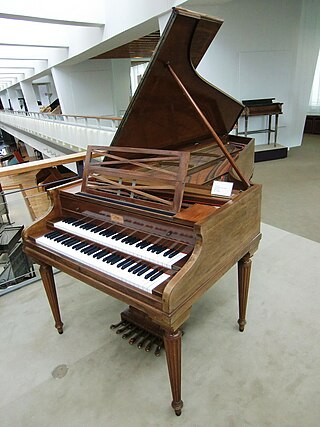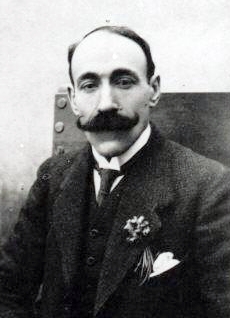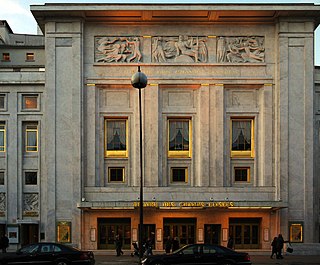Related Research Articles

Francis Jean Marcel Poulenc was a French composer and pianist. His compositions include songs, solo piano works, chamber music, choral pieces, operas, ballets, and orchestral concert music. Among the best-known are the piano suite Trois mouvements perpétuels (1919), the ballet Les biches (1923), the Concert champêtre (1928) for harpsichord and orchestra, the Organ Concerto (1938), the opera Dialogues des Carmélites (1957), and the Gloria (1959) for soprano, choir, and orchestra.

Wanda Aleksandra Landowska was a Polish harpsichordist and pianist whose performances, teaching, writings and especially her many recordings played a large role in reviving the popularity of the harpsichord in the early 20th century. She was the first person to record Johann Sebastian Bach's Goldberg Variations on the harpsichord in 1933. She became a naturalized French citizen in 1938.

Concert champêtre, FP 49, is a harpsichord concerto by Francis Poulenc, which also exists in a version for piano solo with very slight changes in the solo part.
A harpsichord concerto is a piece of music for an orchestra with the harpsichord in a solo role. Sometimes these works are played on the modern piano. For a period in the late 18th century, Joseph Haydn and Thomas Arne wrote concertos that could be played interchangeably on harpsichord, fortepiano, and pipe organ.
The Sonate pour clarinette et piano, FP 184, for clarinet in B-flat and piano by Francis Poulenc dates from 1962 and is one of the last pieces he completed. It is dedicated to the memory of Arthur Honegger, who like Poulenc had belonged to the group Les Six. A typical performance takes 12–14 minutes.

Ricardo Viñes y Roda was a Spanish pianist. He gave the premieres of works by Ravel, Debussy, Satie, Falla and Albéniz. He was the piano teacher of the composer Francis Poulenc and the pianists Marcelle Meyer, Joaquín Nin-Culmell and Léo-Pol Morin.
The Sonate pour flûte et piano, FP 164, by Francis Poulenc, is a three-movement work for flute and piano, written in 1957.
The Gloria by Francis Poulenc, FP 177, scored for soprano solo, large orchestra, and chorus, is a setting of the Gloria text from the mass ordinary. One of Poulenc's most celebrated works, it was commissioned by the Koussevitsky Foundation in honor of Sergei Koussevitzky and his wife Natalia, the namesakes of the foundation.
Pièces pittoresques are a set of ten pieces for piano by Emmanuel Chabrier. Four of the set were later orchestrated by the composer to make his Suite pastorale.

Francis Poulenc completed his Sonate pour violoncelle et piano, FP 143, in 1948. He first sketched it in 1940. It was dedicated to the French cellist Pierre Fournier, who had helped with the technical aspects of the cello part, as the composer was unfamiliar with the instrument. The work was published by Heugel in Paris.
The Concerto pour orgue, cordes et timbales in G minor, FP 93, is an organ concerto composed by Francis Poulenc between 1934 and 1938. It has become one of the most frequently performed pieces of the genre not written in the Baroque period.
Francis Poulenc's Concerto pour deux pianos in D minor, FP 61, was composed over the period of three months in the summer of 1932. It is often described as the climax of Poulenc's early period. The composer wrote to the Belgian musicologist Paul Collaer: "You will see for yourself what an enormous step forward it is from my previous work and that I am really entering my great period." The concerto was commissioned by and dedicated to the Princess Edmond de Polignac, an American-born arts patron to whom many early-20th-century masterpieces are dedicated, including Stravinsky's Renard, Ravel's Pavane pour une infante défunte, Kurt Weill's Second Symphony, and Satie's Socrate. Her Paris salon was a gathering place for the musical avant-garde.

The Piano Concerto in C-sharp minor, FP 146, by French composer Francis Poulenc is the last of his five concertos. Written in 1949 on commission from the Boston Symphony Orchestra, it has three movements and a duration of about 19 minutes.
Francis Poulenc's Sextuor (Sextet), FP 100, is a chamber music piece written for a standard wind quintet and piano. Estimates about the time of its composition range from between 1931 and 1932 and 1932 alone. It received its debut in 1933 but was later revised in 1939. Performed in its entirety, the three-movement piece lasts approximately 18 minutes.
The Sonata for two clarinets, FP 7, is a piece of chamber music composed by Francis Poulenc in 1918. Dedicated to Édouard Souberbielle, its total execution time is about six minutes. It is unusual among clarinet duets in that it is written for B♭ clarinet, which generally plays the melodic themes, and A clarinet, which plays a more supporting role through much of the piece. It is also unusual for music of this period that the clarinetists perform different time signatures simultaneously in parts of the opening movement.

The Sonate pour clarinette et basson, FP 32a, is a piece of chamber music composed by Francis Poulenc in 1922.
The Trio pour hautbois, basson et piano, FP 43, by Francis Poulenc is a three-movement chamber work, composed between 1924 and 1926, and premiered in the latter year.
Élégie pour cor et piano – Elegy for horn and piano – FP 168 is a short, one-movement work by the French composer Francis Poulenc, written in memory of the horn player Dennis Brain, who died in 1957. It was first performed in January 1958.
References
Sachania, M. & Potter, C. Francis Poulenc: Three Novelettes for Piano, Chester Music, revised edition (1999).